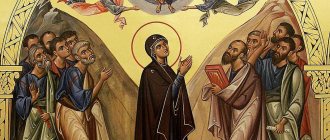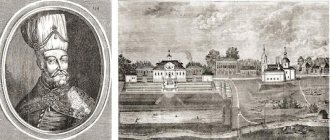The term chasuble has 2 definitions. In the first case, it denotes a phelonion, special clothing for clergy, worn during church services. Also, a chasuble is a setting for an icon, made of gold or embroidered with pearls. This word is also used to describe the clothes of the Most Holy Theotokos, which were found by Constantinople aristocrats after Her Dormition.
Sacred secret - the robe of the Virgin Mary A whole chain of events is connected with this relic. Two Byzantine brothers, having gone to Galilee, decided to visit the city of Nazareth and the house in which the Blessed Virgin lived with Her son Jesus. From the current owner, the young men were able to learn that in one of the rooms there is a sacred relic that heals all diseases - the blind receive their sight, and the lame begin to walk. They saw a shrine called a robe - this is the clothing of the Most Holy Theotokos, which was passed down from generation to generation after Her earthly death. The mistress of the house made the brothers promise that they would not tell anyone about the great secret until this woman died. The young men made a vow, but when they saw the robe of the Virgin Mary placed in the ark, they began to think about what would happen to the relic after the death of the mistress of the house.
Origin of the relic
According to legend, the robe of the Virgin Mary was acquired by two Byzantine aristocrats, brothers Galvin and Candide, who made a pilgrimage to Palestinian shrines during the reign of Emperor Leo I (457-474). In Nazareth, they stopped for the night in the house of an elderly Jewish woman, where they saw a room with many burning candles, continuously burning incense and many sick people thirsting for healing. In response to the question about the reason for such veneration of this place, they heard the following story:
Here I keep the robe of the Most Pure Virgin Mary, who gave birth to Christ God. When She passed from earth to heaven, one of my ancestors, a widow, was present at Her burial; According to the will of the Most Pure Mother of God herself, that honorable robe was given to her; She, having received that robe, kept it with reverence all the days of her life; dying, she gave the robe for safekeeping to one maiden from her family, commanding her with an oath to keep in purity for the honor of the Mother of God herself, not only that honest robe of the Most Holy Theotokos, but also her very virginity
.
— “The Legend of the Position of the Honorable Robe of the Most Pure Virgin Mary in the Blachernae Church”[2]
Detail of the icon “The Position of the Robe of the Mother of God, with Selected Saints in the Fields” (mid-16th century)
Having the opportunity to spend the night next to the shrine, the brothers measured the ark in which it was kept, and then in Jerusalem they ordered a copy of it to be made and a gold-woven cover for it. On the way back to Nazareth, they replaced the ark with the Robe and brought the relic to Constantinople.
The brothers placed the Robe in their home church and kept it secretly, but, according to legend, the numerous miracles that occurred from it forced them to report the relic to the Byzantine Emperor and Patriarch of Constantinople Gennady I. After which, in 458, the Robe was placed in the Temple of God Mother, built on the shore of the Blachernae Gulf (Blachernae Church).[3] In honor of this event, the annual celebration “Position of the Robe of the Blessed Virgin Mary in Blachernae” was established.
Later, an omophorion and part of the belt of the Virgin Mary, discovered in the tomb of the Virgin Mary, opened by decision of the Sixth Ecumenical Council, were placed in the ark with the Robe.[4] This circumstance was reflected in the Orthodox iconography of the holiday, which combines two events: the position of the Robe and the position of the belt of the Mother of God in Blachernae.
The presence of the Robe of the Mother of God in Blachernae is evidenced by the 14th-century Russian pilgrim Stefan Novgorodets:
...we went to Blachernae, to the church of the Holy Mother of God, where the robe, and the belt, and the head covering that was on her head are located. And this lies in the altar on the throne, hidden in the ark, just like the Passion of the Lord, and is even more tightly guarded: chained with iron chains, and the ark itself is made of stone very skillfully
.[5]
— “The Walk of Stefan Novgorod”
Metropolitan Pimen of Kiev and All Rus' writes about his veneration of the Robe in 1387, saying that on the day of placing the Robe of the Mother of God he was in Blachernae and kissed the reliquary there, in which lie the chasuble and belt of the Mother of God.[6]
After the fire of 1434, which destroyed the Blachernae Church, the location of the Riza is lost. It is known that its particles are found in different places: in Russia in the Ark of Dionysius, in the Lateran Basilica of Rome, the Blachernae Church in Zugdidi and a number of other places.
Finding the Robe
Then the brothers decided to use a trick: they went to venerate the Cross of the Lord and promised to come back again on the way back to say goodbye. While on the road, the brothers were able to order an ark that was exactly like the one that contained the robe of the Virgin Mary. The young men also bought a blanket of gold, with which they covered the shrine, asking the mistress of the house in Nazareth to allow them to pray all night in front of the relic. When everyone in the house went to bed, the brothers fell to their knees in front of the shrine, asking the Most Holy Theotokos to forgive them the sin they were about to commit. Having replaced the purchased ark with a true relic and covered it with a golden blanket, the young men went to rest.
In the morning, the brothers said goodbye to their hostess, taking with them the robe of the Most Holy Theotokos. In Byzantium, they founded a small temple in which they placed the sacred clothes of the Mother of God, without telling anyone about it. But the relic was so blessed that the brothers could no longer remain silent and told the emperor about the great find. He reverently accepted the shrine and placed it in the Blachernae Temple. In honor of this event, the celebration of the Deposition of the Virgin Mary was established, which is celebrated to this day on July 15. The location of the relic is currently unknown. She disappeared after a terrible fire, as a result of which the Blachernae Church burned down.
Miracles associated with the relic
The miraculous salvation of Constantinople with the help of the Robe of the Mother of God (fresco of the Princess Monastery, 1648)
The most famous miracle associated with the Robe of the Virgin Mary is the legendary salvation of Constantinople in 860 from the raid of the Rus. The texts of the homilies (sermons) with which Patriarch Photius addressed the inhabitants of Constantinople during its siege by the Rus and shortly after their retreat have been preserved. The second homily presumably dates back to August 4, by which time the Rus had left the area around the city. Photius reports that the attackers left with huge booty. He says nothing about the reason for the departure of the Rus, considering it a miracle that they did not take Constantinople:
For as soon as the Virgin’s vestment went around the walls, the barbarians, abandoning the siege, withdrew from the camp, and we were redeemed from the impending captivity and were awarded unexpected salvation... The invasion of the enemies was unexpected - their retreat was also unexpected...
— Photius’s second homily “On the invasion of the Dews”
Later authors, such as the continuator of the chronicle of George Amartol, Leo Grammaticus and Theodosius of Melitene, report that Emperor Michael III quickly returned to the capital without troops, “ barely getting through
", and together with Photius he offered prayers to God and plunged the Robe of the Virgin into the sea. Suddenly a strong storm arose and scattered the Russian ships, after which they fled. This legend is repeated by the even later “Brussels Chronicle” and “The Tale of Bygone Years”.
According to church tradition, in memory of this event the first akathist to the Virgin Mary was written, which was first read at night in the Blachernae church after the miraculous deliverance of the city from the enemy fleet.[7] This akathist became part of the service of Akathist Saturday - a holiday and rite of the Orthodox Church, celebrated on Saturday of the fifth week of Great Lent. The canon for this holiday was written in the 9th century by Joseph the Studite.
Deposition of the Blessed Virgin Mary
July 15 – Position of the honorable robe of the Blessed Virgin Mary in Blachernae
In the North-East of Moscow, in the former village of Leonovo, there is an 18th-century temple dedicated to a special holiday - the Placing of the Robe of the Blessed Virgin Mary . A celebration associated with the history of a unique Christian relic dating back to the time of the earthly life of the Mother of God - her honorable robe. The transfer of this shrine from the Holy Land to Constantinople has been celebrated for one and a half millennia. And in honor of this great holiday, many churches and monasteries were erected in the Russian Church, including the famous Church of the Deposition of the Robe in the Moscow Kremlin and the parish church in Leonovo , which was not closed even during the years of atheistic persecution.
From the history of the honorable robe of the Blessed Virgin Mary
“The Robe of the Virgin Mary was found in Nazareth by the Roman-Byzantines in the middle of the 5th century. Patriarch Gennady I of Constantinople, having learned about the numerous miracles occurring from the shrine, gave instructions to place it in the ancient Blachernae church of Constantinople. More than once, during enemy invasions, the Most Holy Theotokos saved Constantinople, to which she bestowed Her sacred Robe. This was the case during the siege of Constantinople by the Avars, Persians, Arabs and Rus...”
Indeed, the most famous miracle associated with the Robe of the Blessed Virgin Mary was the legendary salvation of Constantinople in 860 from the raid of our pagan ancestors led by Prince Askold .
Rescue of Constantinople
From the history of the honorable robe of the Blessed Virgin Mary
“Constantinople was almost raised on a spear. In the face of this formidable danger, a decision was made to save church shrines and, above all, the holy robe of the Mother of God, which was kept in the Blachernae church. After a nationwide prayer service, this great shrine was carried with a procession around the city walls and its edge was immersed with prayer in the waters of the Bosphorus, and then transferred to the center of Constantinople - the Church of Hagia Sophia. A miracle happened: the Mother of God, with Her grace, covered and pacified the furious belligerence of the Russian soldiers...”
Soon after this, Askold converted to Christianity, and therefore it is with the Robe of the Most Holy Theotokos that the beginning of the Baptism of Russia . In the 15th century, the location of the shrine was lost. But parts of it remain today. Including in Moscow and Georgian Zugdidi, linking our Orthodox countries with the blessed cover of the Heavenly Lady. And yet, many are surprised why this Byzantine holiday is so revered in Rus', and why so many Russian churches are dedicated to it.
Church of the Deposition of the Robe in Leonovo
As Archpriest Andrei Rakhnovsky , rector of the Deposition of the Robe Church in Leonovo : “The dedication of the temple to this holiday reflected the self-awareness of the Russian people of that time, and this is the 17th-18th centuries, when Russia recognized itself as the legal successor of the Byzantine kingdom. Thus, the idea “Moscow is the Third Rome” is widely known...”
Indeed, the Robe of the Most Holy Theotokos and the holiday associated with it connect not only the peoples and countries of the Orthodox ecumene, but also remind us of the most important historiosophical meaning of Russian churchliness and statehood. And today each of us can come into contact with this greatest shrine in the Church of the Deposition of the Robe in Moscow Leonovo, where a particle of the Robe of the Most Holy Theotokos is kept.
And on the day of the Laying of the Robe of the Most Holy Theotokos, we should ask our Heavenly Lady, among other things, to help Russia preserve the blessed continuity that we received from the first Christian Empire - Byzantium - more than half a millennium ago.
Veneration in Russia
Temple of the Deposition of the Robe in the Moscow Kremlin
A piece of the Robe of the Virgin Mary appeared in Russia in the 14th century. It was acquired in Constantinople by Dionysius of Suzdal among other relics that were included in the “Ark of Dionysius,” which became a significant relic of the Moscow Grand Dukes. In honor of the Feast of the Placing of the Robe, many churches and monasteries were built, including in the Moscow Kremlin (Church of the Placing of the Robe (in the Moscow Kremlin)). Another part of the Robe in the 17th century ended up in the Assumption Cathedral of the Kremlin through the efforts of Prince Vasily Golitsyn.[6] (Not to be confused with the Robe of the Lord, placed in Moscow in the 1st half of the 16th century).
After the confiscation of church valuables by the Soviet authorities, the relic ended up in the Moscow Kremlin museums. In 2008, Russian President Dmitry Medvedev part of the Robe of the Virgin Mary, among other relics, was transferred to the Moscow Patriarchate.[8]
Short story
In 1617, there were two wooden churches here, consecrated in honor of the Nativity of Christ and the feast of the Entry into the Temple of the Blessed Virgin Mary. The current ensemble of “paired” churches was formed in the 18th century
.
In 1749, a stone Church of the Sign was erected at the expense of parishioners. In 1777, with the money of the merchants Zubkov, a “winter” church was built next to the “summer” Church of the Sign
, consecrating it in honor of the Orthodox holiday of the Placing of the Robe of the Virgin Mary.
Notes
- Popov G.V.
Church of the Laying of the Robe from the village of Borodava. M.: Northern Pilgrim, 2006. - 64 p. ISBN 5-94431-179-7. - Legend about the position of the honorable robe of the Most Pure Virgin Mary in the Blachernae Church
- Robe of the Blessed Virgin Mary // Encyclopedic Dictionary of Brockhaus and Efron: in 86 volumes (82 volumes and 4 additional). - St. Petersburg, 1890-1907.
- Church of the Assumption and the tomb of the Virgin Mary in Gethsemane Archived January 6, 2005.
- Walking of Stefan Novgorod Archived January 30, 2012.
- ↑ 1 2
Day of the placement of the Venerable Robe of the Blessed Virgin Mary in Blachernae
(unspecified)
(inaccessible link). Access date: October 6, 2008. Archived May 6, 2009. - The elected governor is victorious
// Orthodox newspaper (Ekaterinburg).
1999 No. 5. (unspecified)
(inaccessible link). Access date: October 6, 2008. Archived April 2, 2008. - A piece of the robe of the Blessed Virgin Mary is displayed for the veneration of believers in the Cathedral of Christ the Savior
Position of the robe of the Blessed Virgin Mary when celebrated
The Orthodox Church annually celebrates the Feast of the Placing of the Robe of the Blessed Virgin Mary. It falls on July 15 according to the new style or Gregorian calendar, which corresponds to July 2 of the Julian or old calendar. Among the feasts of the Theotokos, this event is not as well known as the Annunciation or the Dormition of the Blessed Virgin Mary. Nevertheless, this holiday has special significance for the spiritual life of Moscow. After all, one of the many Kremlin churches, the Deposition of the Robe, was consecrated precisely in honor of the feast of the Deposition of the Robe of the Most Holy Theotokos.
Priest's Robes
In the broadest sense of the word, the chasuble is the robes of the clergy. This particular concept refers to wide clothing, like a raincoat, that does not have sleeves. In front it has a wide cutout so that the priest can move freely during the liturgy. The color of the robe depends on the holiday in honor of which the service is held. For example, on the days of remembrance of prophets and great saints, as well as on Palm Sunday and the Holy Trinity, the priest dresses in green clothes. If the priest has a blue robe in the church, it means that on that day there is some holiday in honor of the Mother of God. The Lord's days can be identified by the golden robes of the priest. If it is Lent, the priests serve in purple robes. The clergy wear red clothes during fasting at Christmas and on the Exaltation. Thus, the chasuble is also a certain symbol of a church holiday.
Architecture of the Church of the Deposition of the Robe
The Church of the Deposition of the Robe in Suzdal has a three-part composition: the main volume of the building, crowned with an onion-shaped dome on a faceted drum, is adjacent to the apse and the refectory. The central volume, elevated in relation to the refectory and apse, has an eight-slope roof with four pediments. Between the “summer” and “winter” churches there is a bell tower - “an octagon on a quadrangle, topped with a hemispherical roof with one dome.
Attraction rating:
Rating 2.00 [1 Vote]
| ← SUZDAL | VLADIMIR REGION Cathedrals of Suzdal | RUSSIA → |
Two meanings
The term chasuble has 2 definitions. In the first case, it denotes a phelonion, special clothing for clergy, worn during church services. Also, a chasuble is a setting for an icon, made of gold or embroidered with pearls. This word is also used to describe the clothes of the Most Holy Theotokos, which were found by Constantinople aristocrats after Her Dormition.
Sacred Mystery - Robe of the Virgin Mary
A whole chain of events is connected with this relic. Two Byzantine brothers, having gone to Galilee, decided to visit the city of Nazareth and the house in which the Blessed Virgin lived with Her son Jesus. From the current owner, the young men were able to learn that in one of the rooms there is a sacred relic that heals all diseases - the blind receive their sight, and the lame begin to walk. They saw a shrine called a robe - this is the clothing of the Most Holy Theotokos, which was passed down from generation to generation after Her earthly death. The mistress of the house made the brothers promise that they would not tell anyone about the great secret until this woman died. The young men made a vow, but when they saw the robe of the Virgin Mary placed in the ark, they began to think about what would happen to the relic after the death of the mistress of the house.








